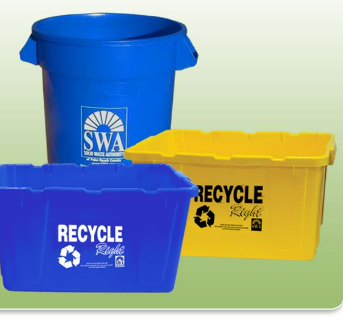SWA recycling rate No. 1 out of 67 counties; surpasses state goal for second straight year
The Palm Beach County Solid Waste Authority’s 2022 recycling rate of 80% was the highest of any county in Florida.
The SWA processes nearly 90,000 tons of recyclables a year. The Florida Department of Environmental Protection’s annual goal for counties is 75%. Collier at 78% and Charlotte at 76% were the only other two counties to exceed the 2022 statewide goal. In 2021, Palm Beach County had a 78% rate.
“Recycling is a community effort and recognition for this achievement goes to the millions of residents, visitors and businesses that participate in our dual-stream system, as well as SWA staff who work toward our recycling efforts every day,” said Executive Director Dan Pellowitz.
He credited the high recycling rate to education programs designed to make the public aware of the need to recycle. The SWA's waste-to-energy facilities also were a major factor in its high recycling rate as the state provides credits to counties with such facilities.

The dual-stream system involves separate bins for paper and plastic products.
According to Pellowitz, the state DEP computes recycling rates based on the total waste processed in a county divided by the amount recycled. The SWA recycles more than 150,000 tons of wastewater treatment residuals (sludge from flushes) into an environmentally friendly fertilizer. The SWA receives additional credits for the amount of solid waste it processes into energy at its renewable energy facilities.
In addition to the material recycled that are placed into the blue and yellow bins, SWA also recycles concrete, construction and demolition debris and vegetative waste. More than 4.2 million pounds of home hazards are disposed of each year.
Anyone who would like to visit the SWA’s recycling facilities can contact Jessica Winter, the SWA’s Recycling Coordinator, at jwinter@swa.org.
To encourage municipalities to recycle, the SWA has set up a revenue sharing program. Since 2010, the program has generated more than $10 million, and nearly $500,000 in the fiscal year ending Sept. 30, 2022, alone. The amount is based on tonnage, so, the more a municipality recycles, the more money they receive. The top recycled items: mixed paper, 32,600 tons; cardboard, 16,500 tons; and glass, 16,000 tons.
Recycling 101: What should you put in the yellow and blue bins?
Blue bin: It's where plastic bottles and jugs, glass jars, food and beverage cans and milk and juice containers should be placed. The lids should be put back on plastic bottles and jugs but kept off glass jars.
Yellow bin: It gets flattened cardboard, newspapers and inserts, mail, magazines and paper bags.
What NOT to recycle: Plastic bags, aluminum foil, shredded paper, napkins, straws and paper plates.
Mike Diamond is a journalist at The Palm Beach Post, part of the USA TODAY Florida Network. He covers Palm Beach County government and transportation. You can reach him at mdiamond@pbpost.com. Help support local journalism. Subscribe today
This article originally appeared on Palm Beach Post: SWA recycling rate of 80% leads all 67 counties in Florida
